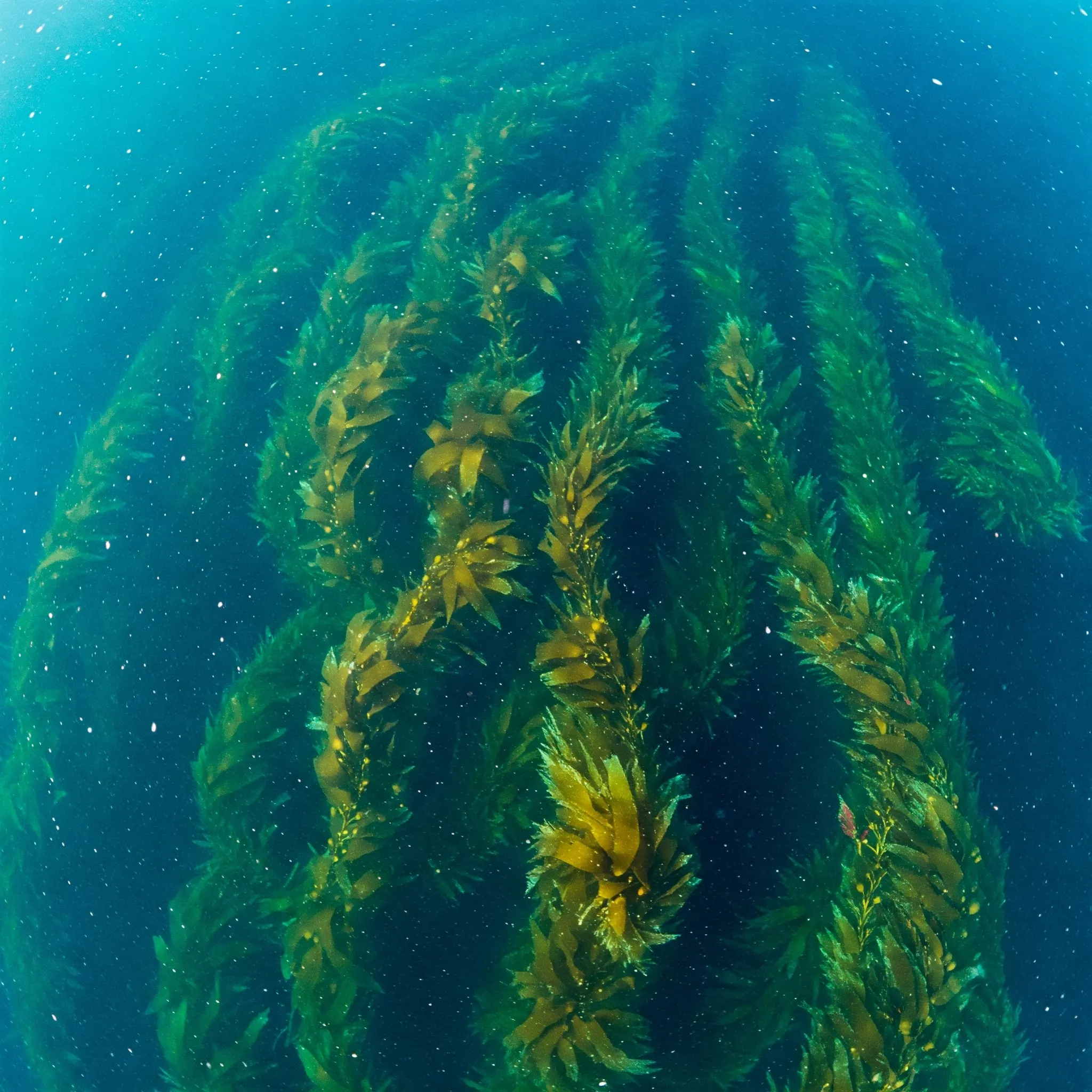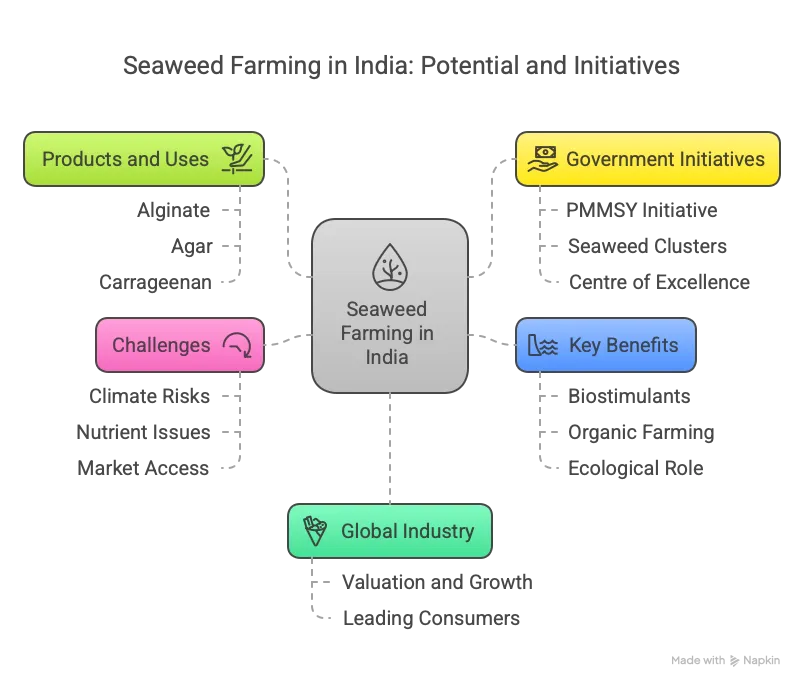UPSC
PIB
Seaweed Farming in India: Economic and Ecological Prospects
Last Updated
4th April, 2025
Date Published
4th April, 2025
Share This Post With Someone

Seaweed farming, an emerging sector in India, leverages the country’s extensive coastline to promote sustainable livelihoods, nutritional security, and environmental benefits. Backed by government initiatives like the Pradhan Mantri Matsya Sampada Yojana (PMMSY), this industry aligns with economic development, ecological sustainability, and social empowerment, making it a vital topic for aspirants preparing for competitive examinations.

Information in Points
Overview of Seaweed
- Definition: Seaweed is a nutrient-rich marine plant growing in oceans and seas, requiring no land, freshwater, fertilizers, or pesticides.
- Nutritional Value: Contains vitamins, minerals, amino acids, and 54 trace elements, aiding in combating cancer, diabetes, arthritis, heart issues, and hypertension; boosts immunity.
- Global Industry: Valued at $5.6 billion, with potential growth to $11.8 billion by 2030 (World Bank); Japan, China, and South Korea lead consumption, using seaweed since the 4th and 6th centuries.
Seaweed Products and Uses
- Alginate ($213 million): Thickener from brown seaweed, used in food, cosmetics, and medicine.
- Agar ($132 million): Jelly-like substance from red seaweed, used in desserts, jams, and lab cultures since the 1960s.
- Carrageenan ($240 million): Gelling agent from red seaweed (e.g., Irish Moss), used in dairy, ice cream, and toothpaste.
- Other Uses: Food, fertilizers, biofuels, and biostimulants for farming.
Seaweed Farming in India
- Coastal Potential: India’s 7,500 km coastline supports seaweed farming as a sustainable livelihood beyond fisheries.
- Species: Of 844 seaweed species in India, 60 are commercially valuable.
- PMMSY Initiative: Launched in June 2020 with ₹20,050 crore for fisheries, allocating ₹640 crore for seaweed cultivation (2020-2025).
- Target: Increase production to 1.12 million tonnes in five years.
- Infrastructure: ₹194.09 crore funds projects like the Multipurpose Seaweed Park (Tamil Nadu) and Seaweed Brood Bank (Daman and Diu); 46,095 rafts and 65,330 monocline tubenets approved.
Key Benefits
- Biostimulants: Enhances crop yields, soil health, and plant resilience; regulated under the Fertilizer (Control) Order, 1985.
- Organic Farming: Supported since 2015-16 via schemes like Paramparagat Krishi Vikas Yojana (PKVY) and Mission Organic Value Chain Development for Northeast (MOVCDNER).
- Ecological Role: Absorbs CO₂, combats climate change, cleans ocean water, and supports marine habitats.
- Economic Gains: Farming Kappaphycus alvarezii yields up to ₹13,28,000 per hectare annually; boosts foreign exchange via exports of biofuels and fertilizers.
Government Initiatives and Developments
- First National Conference (Jan 2024): Held in Kutch, Gujarat, to promote seaweed farming as a job creator; launched Kori Creek Pilot Project.
- Seaweed Clusters: Established in Lakshadweep for production, processing, and export collaboration.
- Centre of Excellence (Mandapam, Tamil Nadu): Launched January 9, 2025, for research, seed banks, and job creation (5,000+ jobs for 20,000 farmers).
- Import Guidelines (October 31, 2024): Allows importing live seaweed varieties to diversify from disease-prone K. alvarezii.
- Coastal Aquaculture Authority Act (2023 Update): Simplifies rules for eco-friendly seaweed farming.
- Gujarat Efforts: Promotes cultivation in the Gulf of Kutch (Kori Creek).
Success Stories
- Women Empowerment (Mandapam, Tamil Nadu): Jeya Lakshmi, Jeya, Thangam, and Kaleeswari invested ₹27,000 with TAFCOFED support, producing 36,000 tonnes of wet seaweed despite challenges like cyclones, creating jobs for other women.
- Tissue Culture Breakthrough: CSIR-CSMCRI’s technique in Tamil Nadu mass-produced K. alvarezii, yielding 30 tonnes in two cycles with 20-30% higher growth and better carrageenan quality.
Challenges and Future
- Challenges: Climate risks, nutrient issues, and market access hurdles persist.
- Government Support: PMMSY and Seaweed Park initiatives aim to overcome these, fostering growth.
- Conclusion: Seaweed farming enhances coastal livelihoods, sustainability, and economic growth, with innovation driving its potential.
Glossary
- Seaweed: Nutrient-rich marine plant used in food, industry, and medicine.
- PMMSY: ₹20,050 crore scheme to boost fisheries and seaweed production.
- Alginate: Thickener from brown seaweed for food and medical use.
- Agar: Gelling agent from red seaweed for food and labs.
- Carrageenan: Red seaweed extract used in dairy and processed foods.
- Biostimulant: Natural substance enhancing plant growth and resilience.
- Kappaphycus alvarezii: Commercially valuable seaweed for carrageenan production.
- Tissue Culture: Technique to mass-produce high-quality seaweed seedlings.